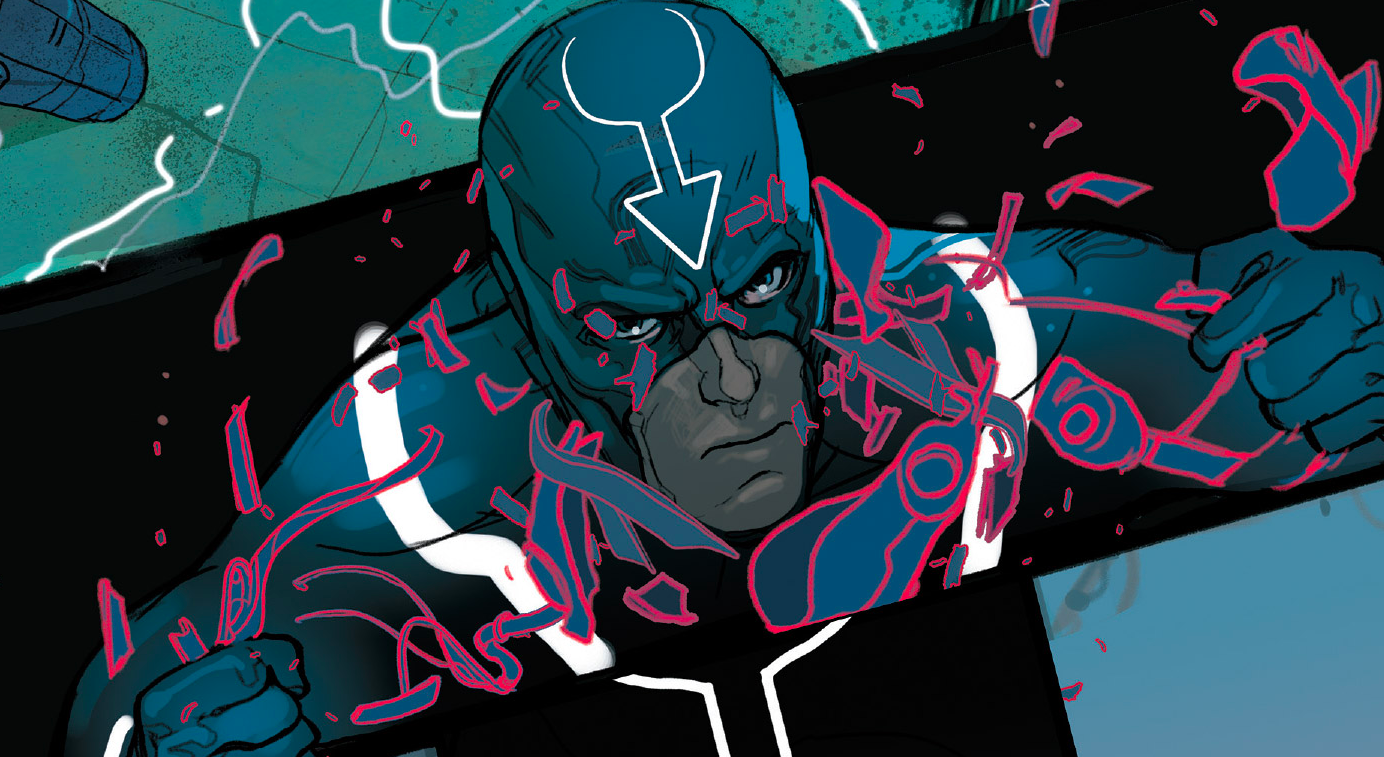While the Inhuman royal family’s live-action debut last fall was, erm, let’s be generous and call it hot garbage left out on a summer’s day, do not fret dear Marvel fans! The royal king of the Inhumans, Blackagar Boltington (yes, that is his real name) is fairing much better in the comics. Well, better quality wise as his solo-title sees him suffer quite a bit at the hands of the creative team of Saladin Ahmed and Christian Ward and the villainous Jailer.
As an introduction to the character of Black Bolt, you can’t do any better than this volume. Collecting the first six issues of Ahmed and Ward’s twelve issue run, the volume is a thriller seeped in cosmic psychedelia complete with a jailbreak, a colorful cast of characters, a deeply flawed main character, and a heartbreaking redemption arc. If you’ve never had any experience with Black Bolt and the Inhumans, the first issue gives you all you need to know through some truly creative and beautiful panels. One such page is modeled after an MC Escher painting and sees Black Bolt walking through the interstellar prison he’s been trapped in. In the background are bits of who he is and how he got here and, later in the series, we learn more and more about his tragic backstory.
Upon first opening the volume, you are greeted by a fairly simple page. The first panel is a black box with some small, white text. It is short. It gives you all you need to know. The next three panels elaborate, slowly revealing that someone has been bound, chained, muzzled. He has no memory of who he is or where he is. The next page sees a voice yell “Name your crimes! Repent your crimes!” before the muzzled man is shocked.
He remembers that he is not a criminal but a hero. A king. He remembers this as he falls into unconsciousness… or something worse. Upon turning the page, the sequence repeats, albeit differently. We know more information this time and as the repetitions continue, we, along with Black Bolt, gain our footing. We began by being disoriented, stuck in the deep black-blue darkness but now, through the patterns, we are no longer confused, and we are ready to escape the cycle. From there the adventures, or more accurately the trials and tribulations, of Blackagar Boltington, the Midnight King, the Most August Ruler of the Inhumans, begins.
In just these few pages, Ward and Ahmed show their mastery of their respective crafts as well as what a truly magnificent creative team can accomplish. Christian Ward’s art is just gorgeous to behold, and Ahmed’s sharp dialogue manages to be funny, heartfelt, dramatic, and most of all, genuine, all at once. Every character is fully realized through Ward’s command of posing and facial expressions. The prison they are trapped within is ever-shifting, massive, and oppressive which Ward manages to capture and convey perfectly.
The comic is bathed in deep neons, both bright and dark, and Ward’s lineless digital art gives the world that constantly shifting feel I just mentioned. He turns every page into a canvas, from the largest battles to the smallest conversations. What is most impressive about his work, though, is his paneling. Let me give an example from Issue four. Crusher Creel and Black Bolt have been chained up and are just talking.
In this scene, Ward does something unconventional for the series so far – he sticks to a nine-panel grid for the Crusher focused flashback sequences. Anytime Black Bolt or present Crusher are in the panel, the comic breaks from the very rigid grid. Let me explain. On one page, the top three panels are laid out as you would expect for that grid: all the same size, all spaced out the same way. Then we get Black Bolt and Crusher talking once again in these skinny panels that are recessed into the center of the page more than the grid panels. Then, for the final panel of the page (which is a shot of a cop car from the past), it is back to the perfect grid panel, placed as if the whole page were a normal nine-panel grid.
The present is visually distinct from Crusher’s past, as one is constructed, a story that has neat delineations, while the other is the present, a messy and tense time. As such, as the flashbacks creep closer to present day, the grid starts to bend and break. There are still nine panels per page but by the second to last full flashback page, the grid morphs, growing to show the increasingly complex nature of Crusher’s life. When we get Black Bolt’s single flashback page, the panels are a jumbled mess, strewn about the page, reflecting Black Bolt’s own view of himself at the moment. Is he a good man? He does not know. Nor does he know how to arrange his past.
Honestly, issue four is probably the strongest of all the issues in this volume and considering all six issues have the same level of quality, that is high praise. This volume and this series is an analysis of Black Bolt, of what it means to be a father, of what it means to be a prisoner. Of what it means to be a good person and how one can reclaim goodness for themselves.
Beautifully written, beautifully drawn and heartbreakingly bittersweet, this is comics at some of its finest. Give it a read.
Featured Image Credit: Google Photos

